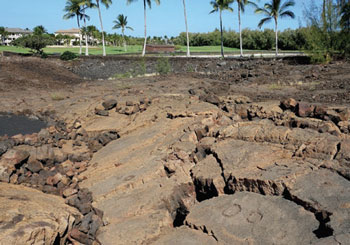If your reaction to flying into the Kona International Airport for the first time was, “We just landed on the moon,” you are not alone.
The vast fields of brown and black lava one sees from an airplane window look quite a bit like what we’d expect of a lunar landscape. Stretching from mauka to makai all along the Kona-Kohala Coast, they are a stark and magnificent sight that not even those who have traveled far and wide are likely to have seen before.
Born of the molten issue from Hawai`i Island’s family of five volcanoes — Mauna Kea, Mauna Loa, Hualālai, Kīlauea, and the Kohala Range — the dozen or so distinct lava fields we drive through to reach Waikoloa Beach Resort from the airport (which itself is built atop a lava flow from Hualālai) are anywhere from 156 to tens of thousands of years old. The most recent eruption in this area came from Mauna Loa in 1859; the lava flow on which Waikoloa Beach Resort is built is thought to have occurred in 1800-1801.
Islands Born of Fire
On the south end of the island, 100 miles from the Kohala Coast resorts, Kīlauea Volcano has been spewing lava continuously for more than 30 years, sitting atop the underwater “hot spot” in the 3,600-mile-long Hawaiian Island-Emperor Seamount chain.
According to the U.S. Geological Survey, “All the Hawaiian Islands owe
their existence to this hot spot in the Earth’s mantle that has changed location only slightly over the past 70 million years. Countless eruptions of lava fed by the hot spot built volcanoes that eventually grew above sea level to form (the Hawaiian) islands.
“But because the seafloor on which they were built was continually moving northwestward across the hot spot at a rate of 7-9 centimeters per year, eventually each volcano was torn away from the hot spot and carried northwestward, just as a conveyor belt moves material from one location to another. Such is the (eventual) fate for the active volcanoes on the Big Island, though they will be replaced by new volcanoes.”

